Oh, I love the simplicity of digital products! They are easy for the teacher to prep–just click on the file–have all of the fun color graphics, and are paperless!
Try this FREEBIE today and see what you think!

Oh, I love the simplicity of digital products! They are easy for the teacher to prep–just click on the file–have all of the fun color graphics, and are paperless!
Try this FREEBIE today and see what you think!
Two new syllabication packs are posted MAGNETIC Y
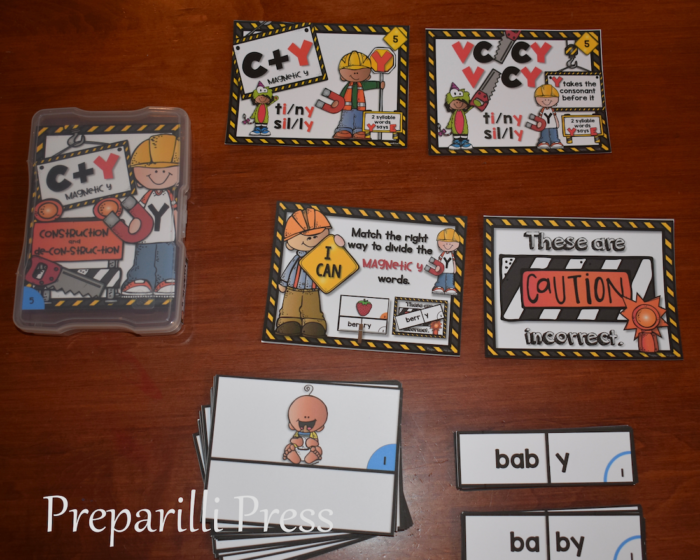
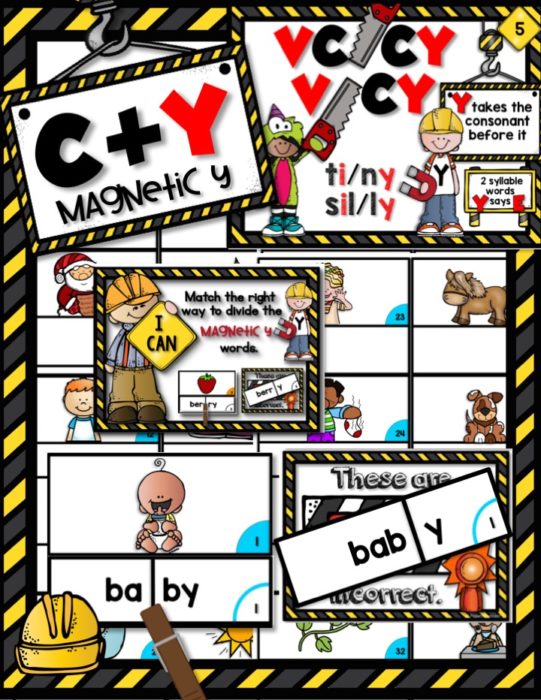
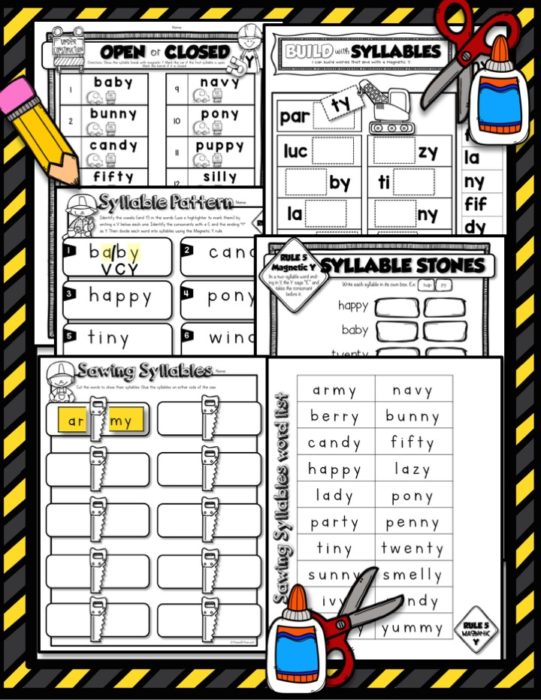
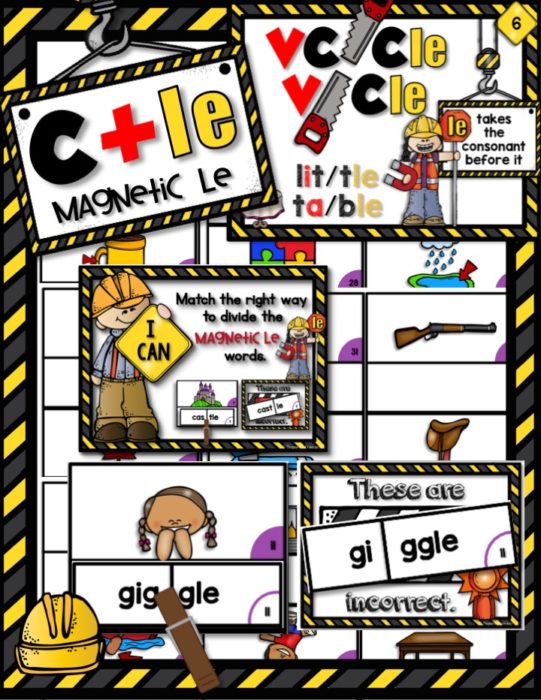
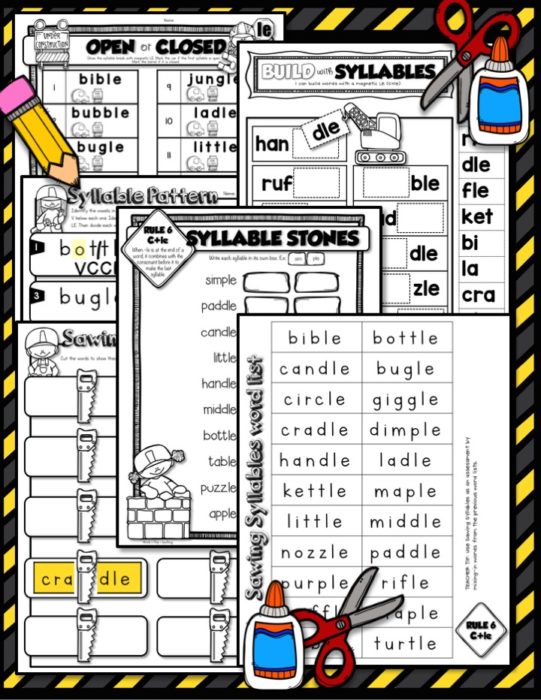
These are the fourth and fifth pack in our series and both build on the VCCV and VCV syllabication rules taught in the earlier packs. They are both half-off through Sunday!!
A little digital something for your Second graders–TOTALLY TECHIE TRIGRAPHS! These are perfect for your Google Classroom, or homeschool. The files in this set will run on any computer that has access to Google Slides or PowerPoint.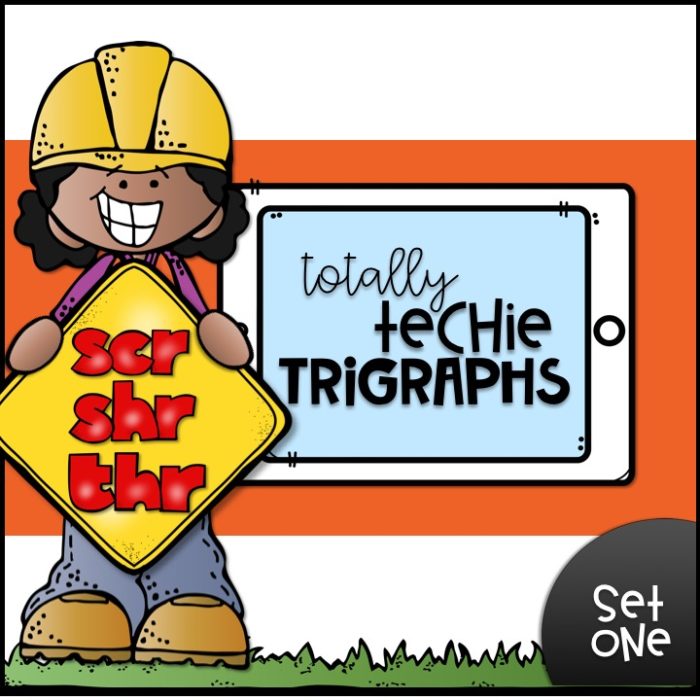
Three activities are included in this set:
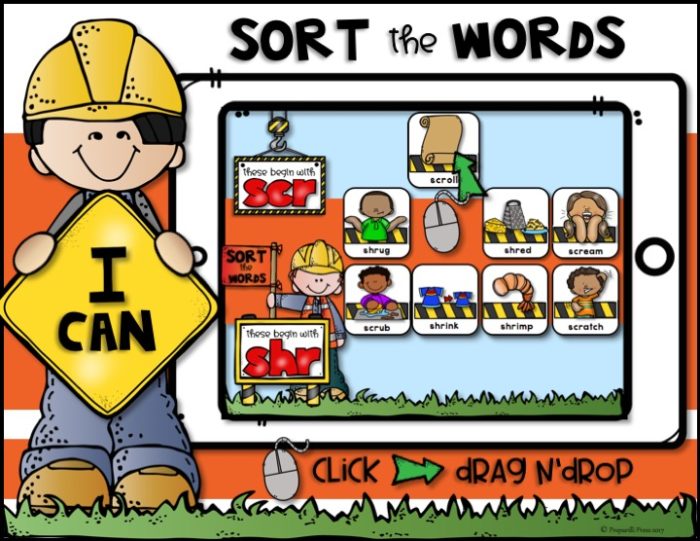
In this first activity your students will sort SCR- and SHR-; SHR- and THR-; SCR- and THR- words. The words are included on the picture sorting cards. Simply click on the word card; drag and drop it next to its beginning blend.
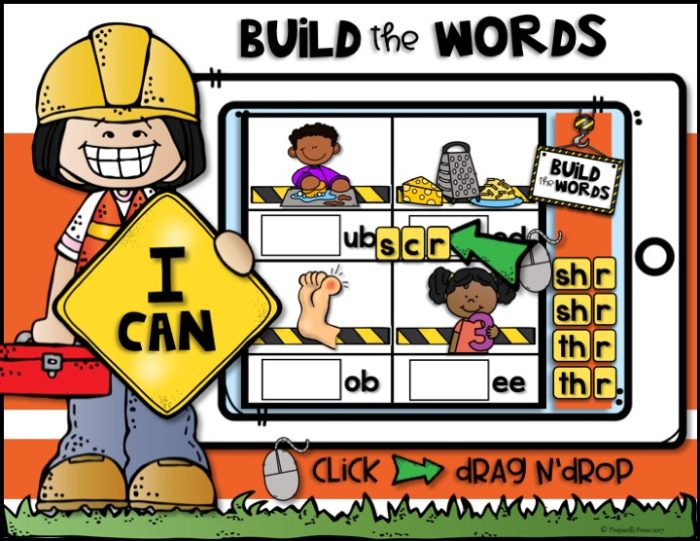
Your students will drag and drop the right beginning trigraph for each picture. Not all beginning blends will be used.
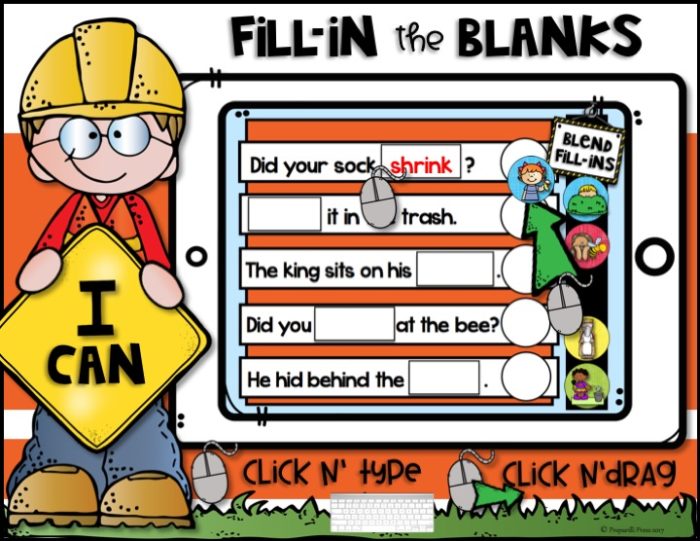
A printable word list included for this activity. Your students will type the word in the blank to complete each sentence. Then they will drag n’drop the picture that matches the sentence.
The text boxes in this activity are designed to use the KG What the Teacher Wants font. Click on the link to download your free copy. You will need to install it on your classroom’s shared drive, or on the computer that will run these files.
Every file in this set has movable pieces (only the pieces that need to move actually can be moved), so once a student has completed an activity and you have checked their work, close the file by clicking “DO NOT SAVE.” That way the pieces they moved will go back to their starting positions and the program will be ready for your next student.
TOTALLY TECHIE TRIGRAPHS will be half-off this weekend!
Another year has passed, and a lot of books have been read around here. I asked each of the kids to pick their Favorite Read from the 2016-2017 school year, and here is our first review. It is from Finn, age 6. He just completed Sonlight’s Core B (First Grade). He really wanted to tell you his TOP 7 favorite books (Mr. Popper’s Penguins, Homer Price, Missionary Stories with the Millers were rated high on his list, too), but here is the one (okay, two) he gave top honors to:
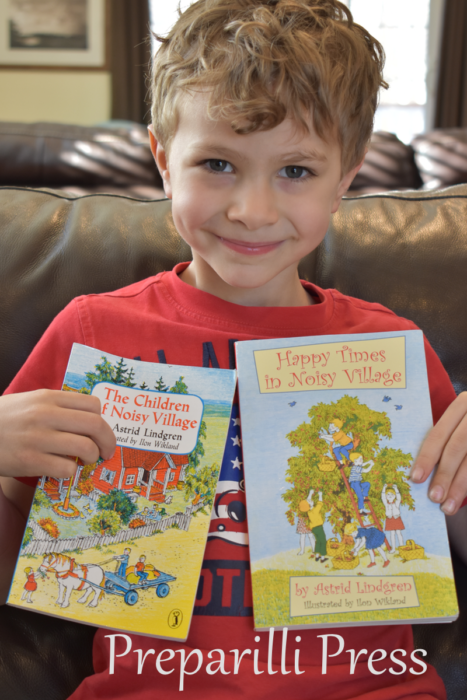
Finn, age 6
Would you pull out your best friend’s tooth in the middle of the night? Karl Erikson, D.D.S (extracts teeth under complete anesthesia, or a good night’s rest) did that for his friend, Olaf. He is one of the happy kids from Noisy Village.
Happy Times in Noisy Village was my favorite book this year because it is really funny. There are stories about the things kids do every day that will make you laugh. One time the boys took over the girls’ snow-fort and the girls had to make snowballs for them for the rest of the day. Another time the kids were trying to sell cherries along the side of the road. It was a busy road, and nobody would stop. Karl started getting angry about no one stopping, so he jumped out in the middle of the road (sort of) and a car stopped. The story about Olaf’s loose tooth is the funniest. You’ll just have to read that one!
We had some fun this week celebrating sping and looking forward to Easter. My kids love it when we celebrate with a photo booth (Krista’s props make them especially fun) and I love it when we work on their writing skills :). So, I put together some fun spring writing activities that you can use as crafts, as a display, or in a photo booth like we did.
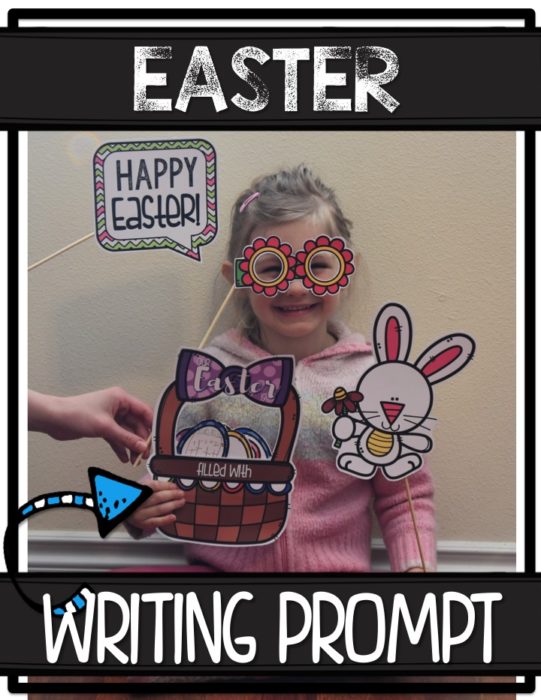
1. Our Easter is Filled With—Why is Easter special? How do you celebrate it? Your students will write and draw about their Easter traditions using this brainstorming writing prompt. They will put each idea on a separate egg and then place it into their Easter basket.
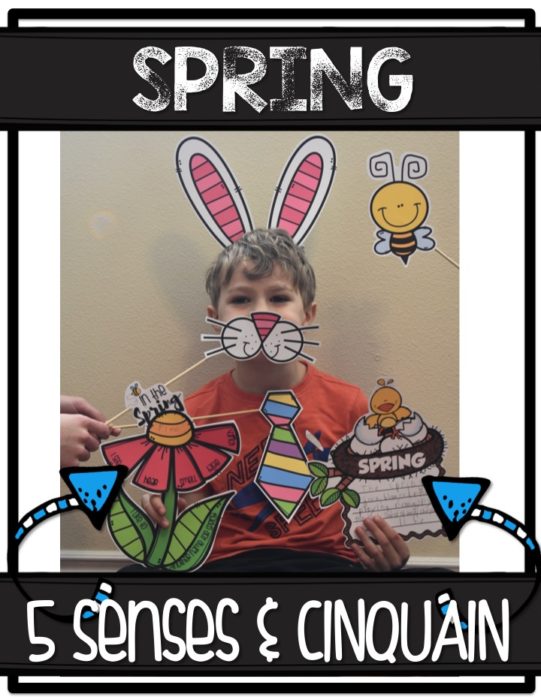
2. In the Spring (Five Senses)—Using their five senses and descriptive words, your students will write about spring. Their responses can then be used to write a spring cinquain. Four colors of flowers are included.
3. Spring Cinquain—Your students will use the descriptive phrases and action words they came up with for “In the Spring” to write a Cinquain (a short, unrhymed 5 line poem of 22 syllables). Cinquain poster and instructions are included.
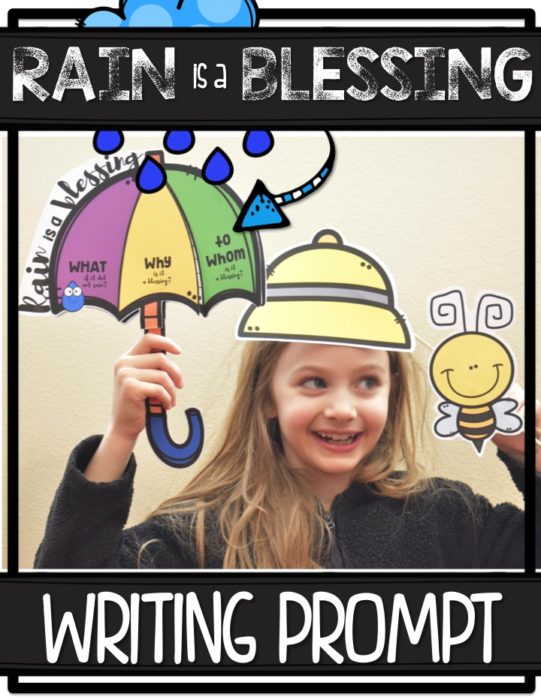
4. Rain is a Blessing—Your students will ponder HOW (what if it did not rain), WHY, and to WHOM rain is a blessing in this photo booth writing craft. This also a fun writing craft to use after discussing the water cycle.
Grab this set of PHOTO BOOTH WRITING PROMPTS for half-off today only!
Are you helping your students develop a solid understanding of phonemes–the sounds letters make, either alone or in concert with other letters? This is the year to do just that! In First Grade, students are introduced to so many new letter combinations and sounds it can be a bit daunting to teach. Today, I’m going walk you through our approach. We are aiming for comprehensive, cohesive instruction that encourages a LOVE for words + learning = great readers and spellers!
1. INTRODUCE the NEW PHONEME
Most of your students will be familiar with the QU digraph (it isn’t a literal digraph, but for arguments sake, lets just call it one :). They are familiar with the QU pairing (Q is always written with U). But, take the time to review all of the words they can already read with this digraph. We began by matching pictures to their words on the quilt (in our Interactive Phonemic Notebook). We also used a QU slider (from our QU flapbook) and segmenting and blending cards.
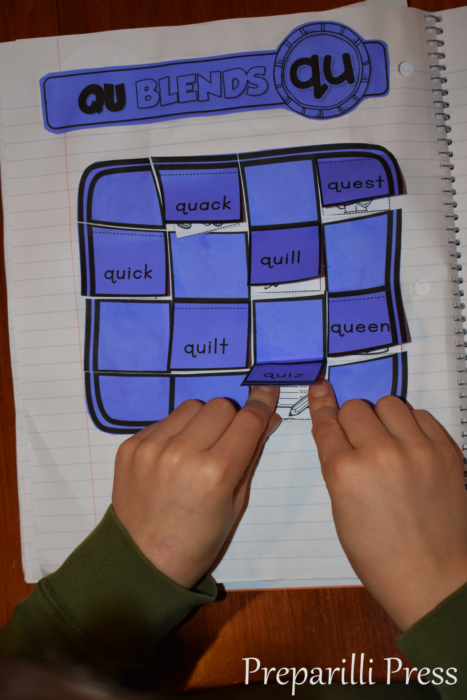
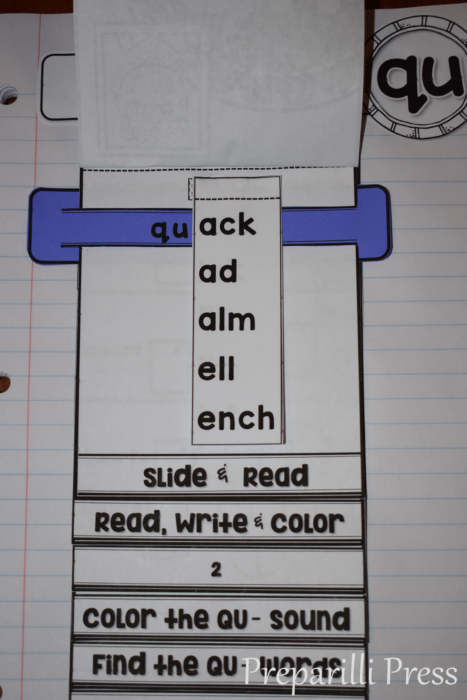
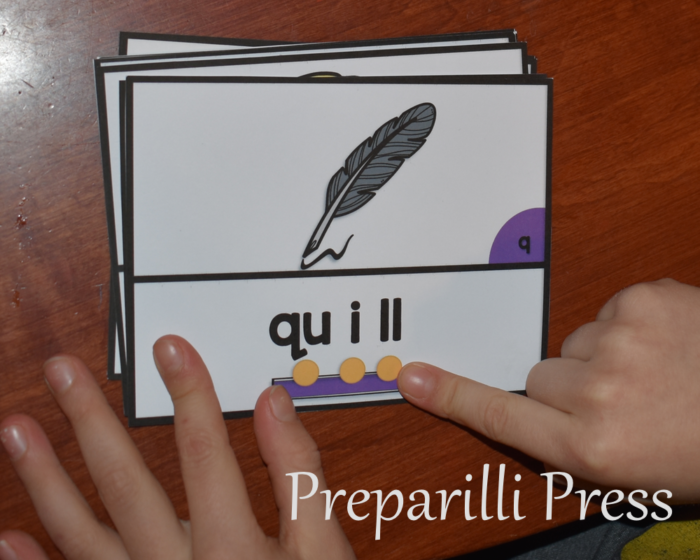
2. MAKE a PHONEMIC POSTER
This is a FUN way to get your students using new sounds and working on alliteration. I always have my own poster ready (I’ve made a new one for QU), but BEFORE I show it to them, I have my kids make their own. This is how we do it:
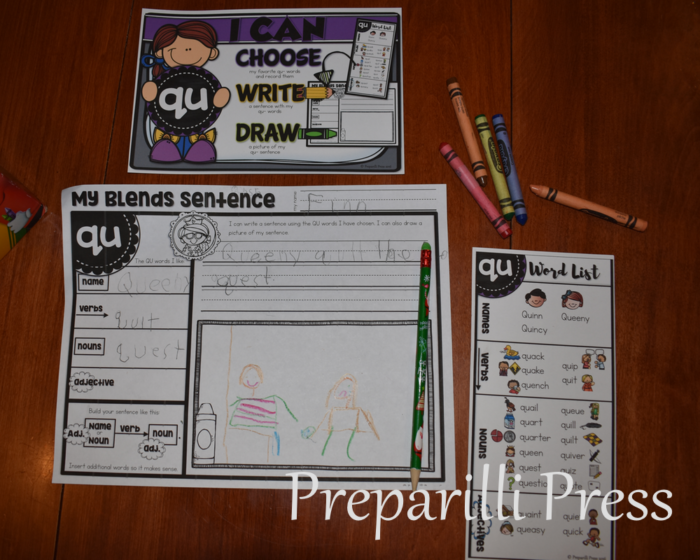
I give them a graphic word list (the words are categorized by names, verbs, nouns and adjectives) and ask them to pick their favorites and write them down on the My Blends Sentence sheet. Then, they follow the formula to make a sentence and draw a picture to demonstrate it. Once they are finished, we go over their blends sentences and I show them mine:
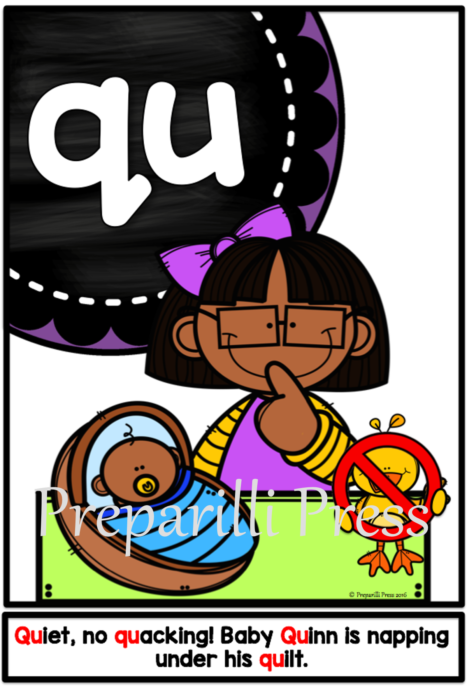
3. TIME to DEVELOP YOUR PHONEMIC MUSCLES
Next, we jump back into our Interactive Phonemic Notebook and learn new words (the new words are also presented on the Segmenting/Blending Cards). We will read, write, recognize, and segment them.
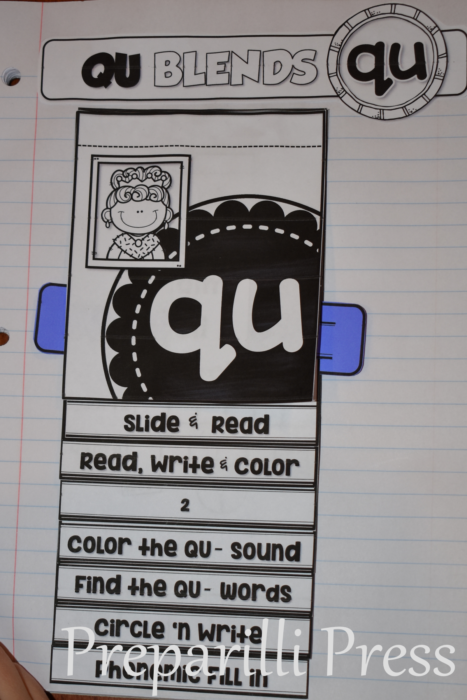
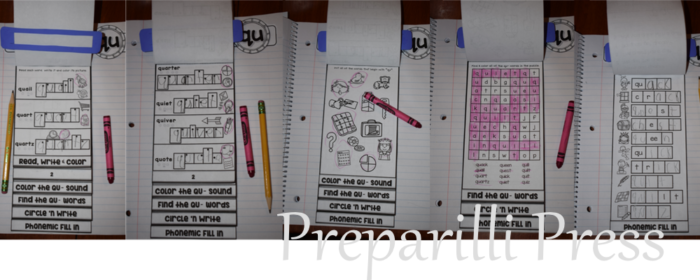
This is a great time to review other words (with blends and digraphs recently mastered) that rhyme with the target sound (QU) words.
4. PHONEMIC SPELLING and ABC ORDER
Now its it time for phonemic spelling–using the words your students can sound out (recalling blends and digraphs already learned). We make it FUN with Phonemic Strips (the arrows in the picture) and a place to store them (the quiver).
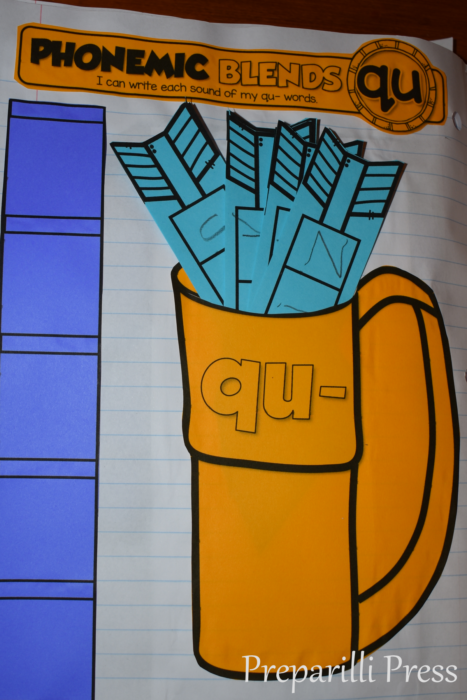
We use the Phonemic Strips to practice alphabetical ordering. This is a nice challenge since all of the words we are working with this week begin with QU. The sliders help to hold each word in place. Once the order is correct, the words are recorded.
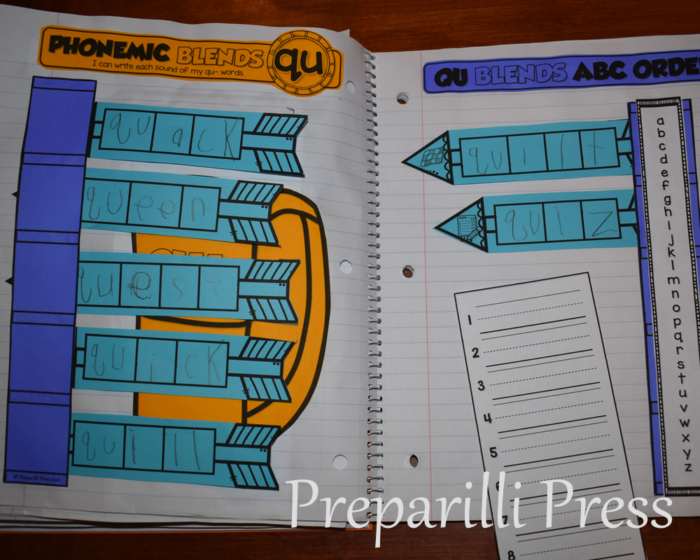
5. BLEND ME a STORY
Now that your students can recognize so many new words, they should use them. Writing a quick story focusing on the target blend (QU) is a FUN way to do just that. 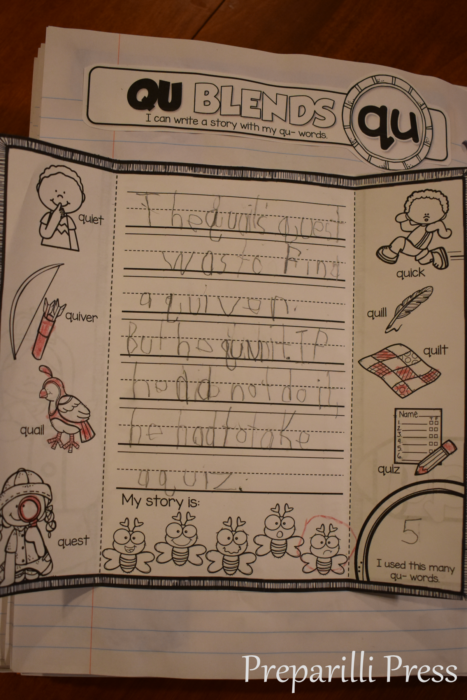
6. SHOW ME what YOU KNOW {PHONEMIC FLIPS}
After all of the great word work your students have done with QU it is time for them to have some FUN showing you what they know. They will do this with the QU Phonemic Flips.
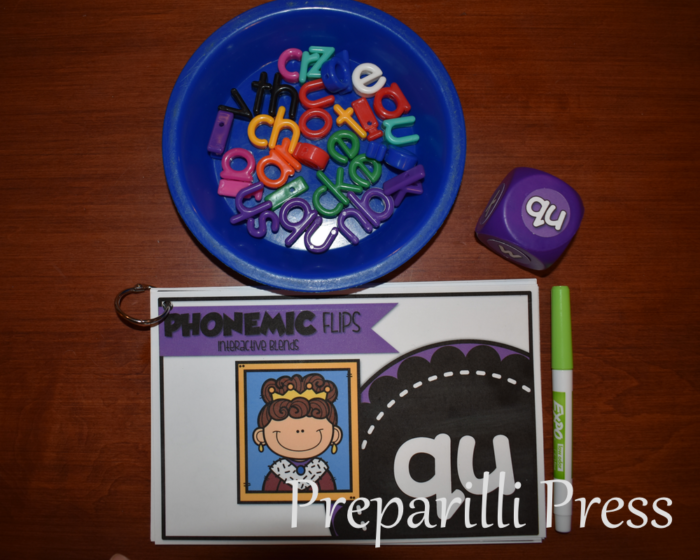
With this interactive blends booklet, they will use a dry erase marker, a blending dice–I like using foam dice :), but you can easily build the blends dice included in the pack–and lowercase letter manipuatives. I know a lot of you are fans of the magnetic letters. You are welcome to use these instead of the lacing letters we use. {Flip}
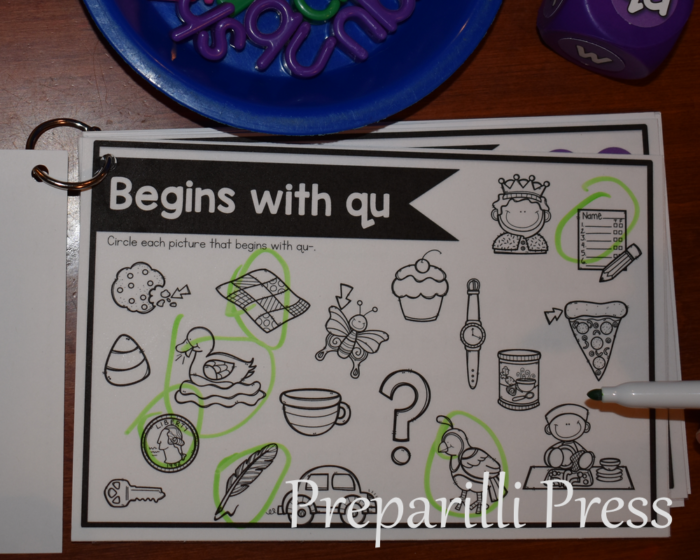
Circle all of the pictures that begin with the target sound (he circled “question” after I took the photo :). {Flip}
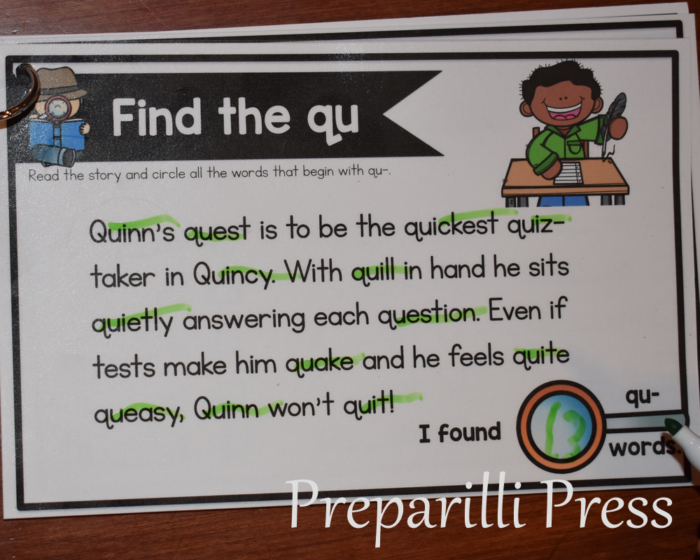
Read the passage and find all of the words that begin with QU. I try to keep these stories as simple (and funny) as possible; but your students will need help with a few of the words (i.e. taker, answering, question, queasy). {Flip}
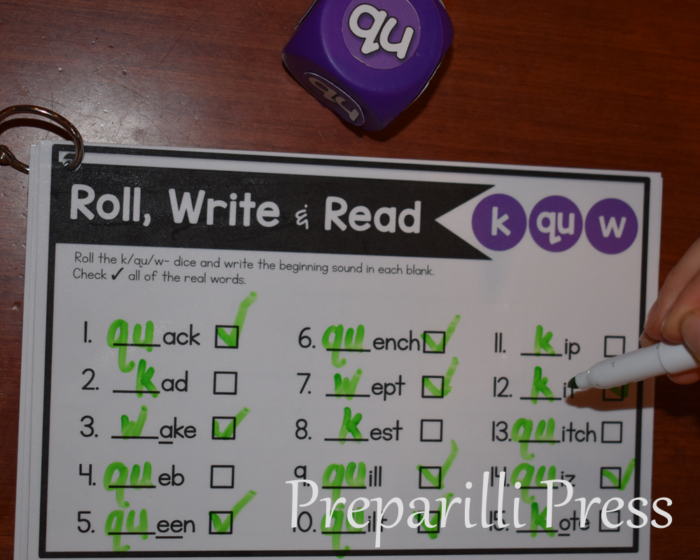
Now its time to use the dice (this is my kids’ favorite task–it turns into quite a game). This is where you’ll be able to assess the strength of your students’ phonemic muscles. They will roll either a K, QU or W and write it in the blank. Then sound out the word and decide if it is real, or not. Only real words receive a check mark. {Flip}
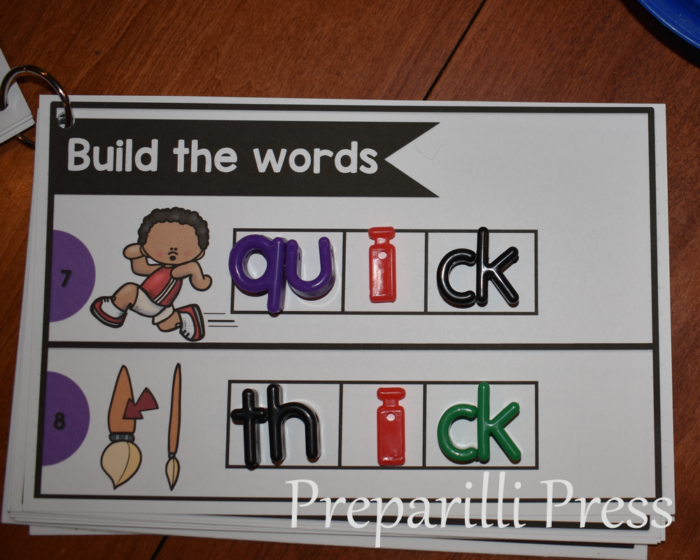
Using the letter manipulatives, your students will build the words we have worked on all week, phoneme-by-phoneme. One thing I like to do at this stage of word development (which you might not be used to 🙂 is link the letters together that make the new phonemes (I heart glue dots). So, in this photo the QU, CKs and TH are glue-dotted together. This is a simple technique that will help your students recognize that these letter pairs stick together to make the new sounds they are learning. And the great thing about glue dots is they hold tight, but are easy to remove. As your students’ phonemic learning progresses, the glue dots disappear. {Flip, flip, flip, flip, flip–there are 20 words in this section}
7. REVIEW THOSE DIGRAPHS and BLENDS
Great readers and spellers don’t develop overnight, so reviewing what is learned is always helpful. We like these word building exercises (they are a part of our Interactive Phonemic Notebooks–pictured next to the QU story).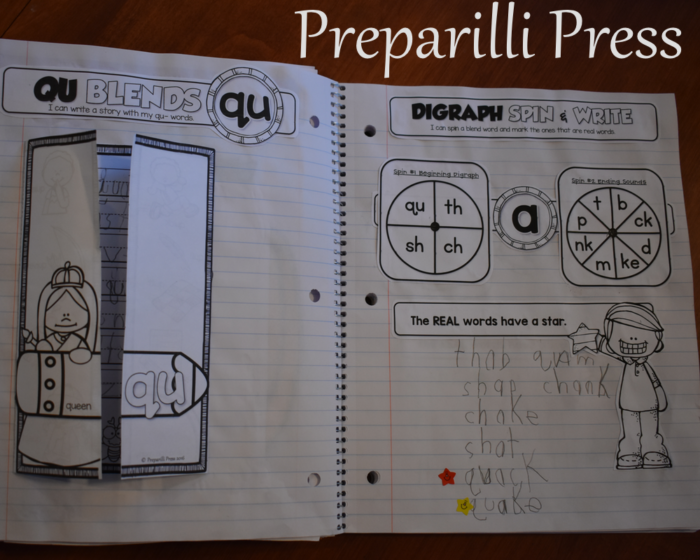
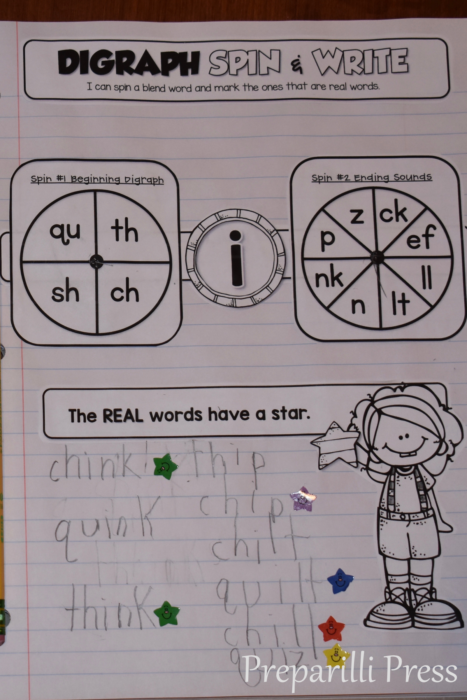
And this PENCIL BOX independent work center: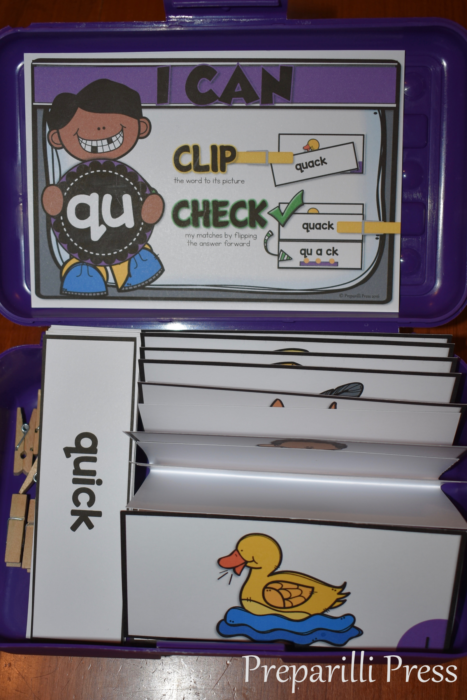
Simply take the segmenting/blending cards and fold them along the mid-line: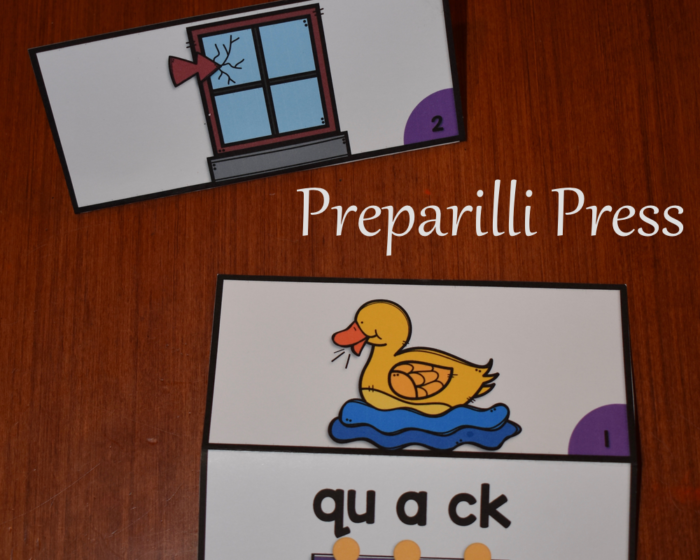
Using clothespins, your students will attach the word to each picture and then self-check, flipping the segmented word forward to match the word they have attached.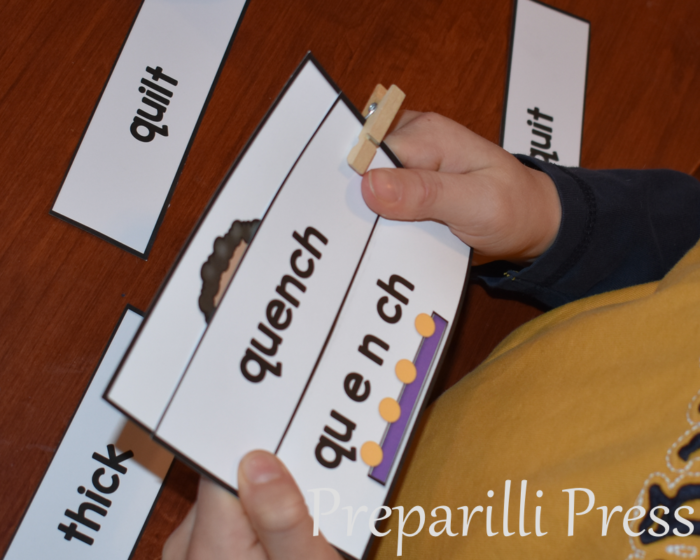
So, that is how we do it! What do you think? Are you ready to dive into phonemic instruction & word building?

For all of my fabulous followers…here is the second fall Flash Freebie (today only)…
PHONEMIC L-BLENDS for your INTERACTIVE NOTEBOOK!
If you are not using an interactive notebook for your First Graders’ word work, this is a GREAT place to start! Easy prep for you, lots of great practice for your students. The added bonus is that you will have an awesome resource to use all year long (not a bunch papers to teach’n’toss)!
Each of L-Blend (bl-, cl-, fl-, gl-, pl- and sl-) has a:
1. Word Family Flaps with Picture Tiles–a fun, hands-on way to introduce words
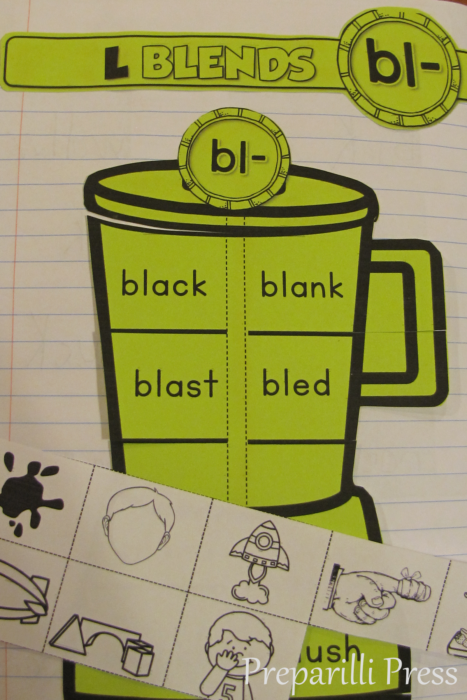
2. Flip-book—These are easy to prep and include the following pages:
1. Slide and Read
2. Read, Write and Color—interactive presentation of blends
3. Color the (BL-) Sounds—choose the pictures that begin with the target blend
4. Find the (BL-) Words puzzle
5. Circle ‘n Write—read the sentences, find the (BL-) words and write them on the lines provided.
6. Phonemic Fill-in—Review of words; spelling using phonemes
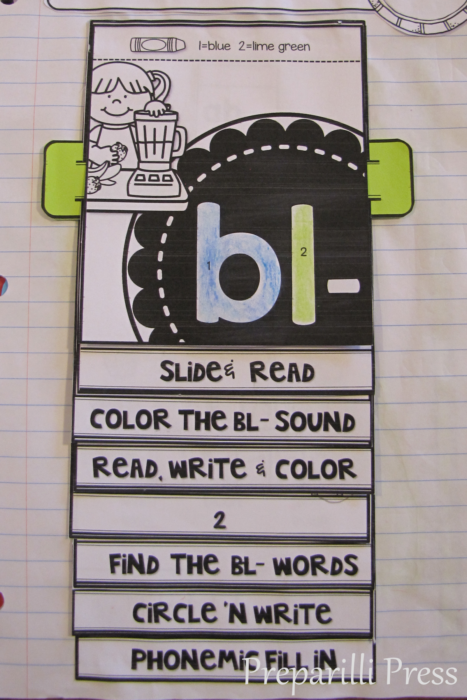
3. Phonemic Strips and a Pocket for storing them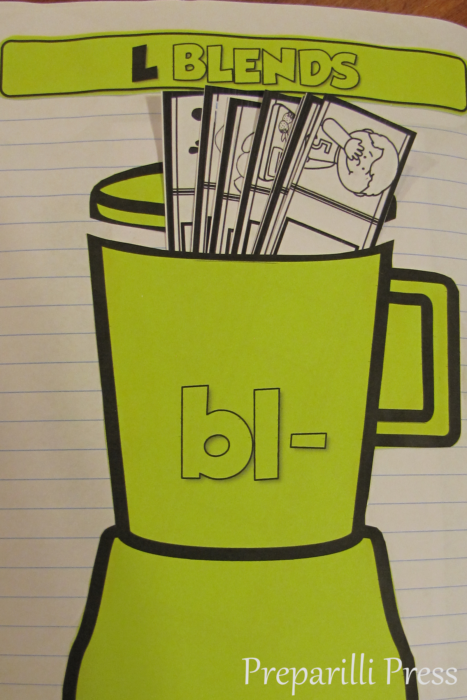
4. L-Blend Storyboard–your students will use their L-blends to write a story (or a couple of sentences)
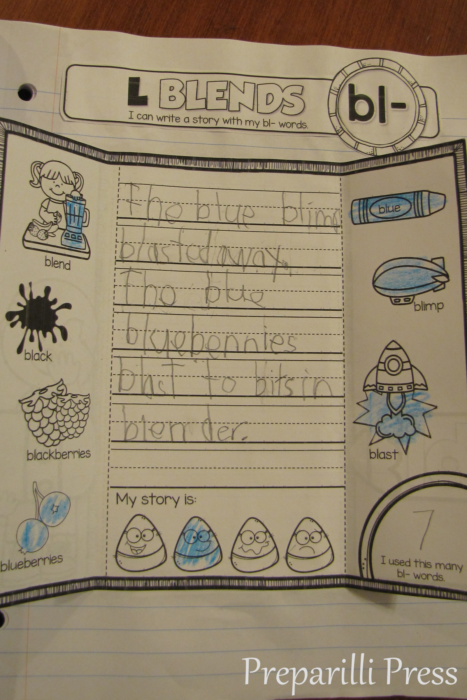
PLUS…Interactive tools for ABC Order that you can use throughout this word study.
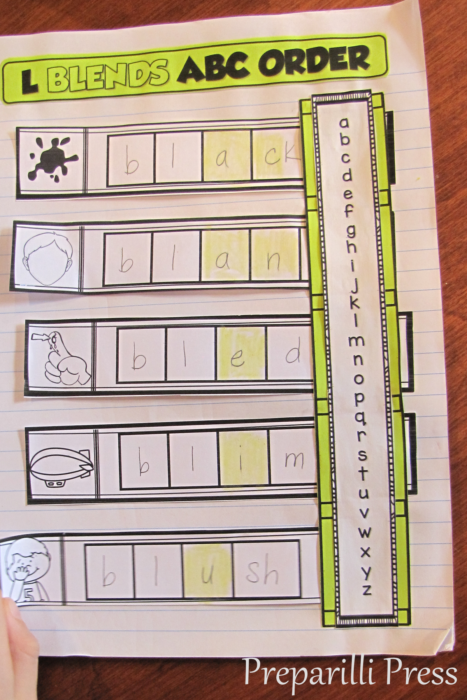
And… some great review–Word Building with L-Blends.
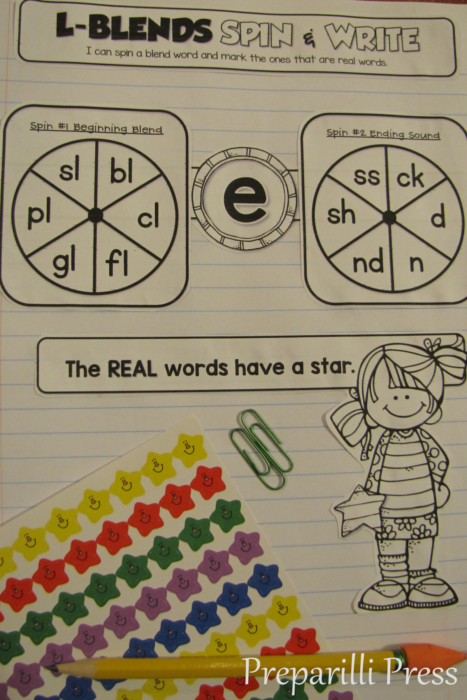
Hope you LOVE it! Go grab it FREE today!
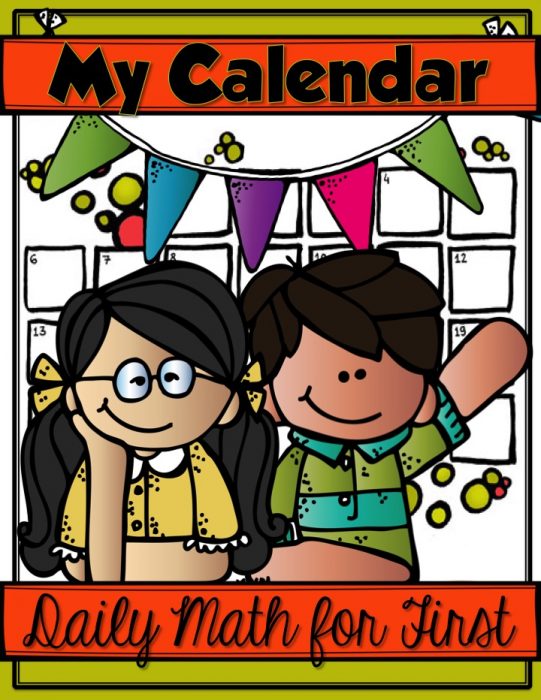
We’ve got something new for you to try! Daily Math review for First Graders! It is a perfect way to spend your calendar time each day. These pages are loaded with calculations, computations and creative hands-on learning. They are a great assessment tool for you, too

We start each month with a look ahead (and behind ;)! Your kids will color the month (and the one before and after). They will write the ordinal number of the month (the cards from our Calendar Companion come in handy here) and the number of days in the month (numerically and with words). They will also note the day of the week that the month begins and the season. Plus, they will count the number of months left in your school year, the number of holidays and celebrations in the month, and the number of months until their birthday. Lots of great calendar learning!
For each month (AUG-JUNE) There are five sheets that you can rotate through the days of the week. There are some tasks that are present on every sheet. These are related to the date and Days in School computation.

Do your students compute their Days in School? Don’t just give them the answer! They can do it themselves with these handy helpers:
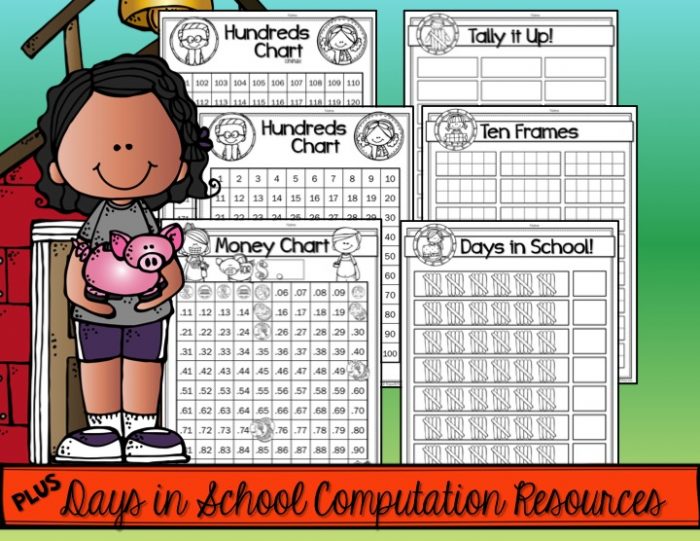
During the first few months of school we use the Tally it Up! and Ten Frames to count the days. As the weeks go by, the Days in School sheet becomes the most useful (and quickest to use).
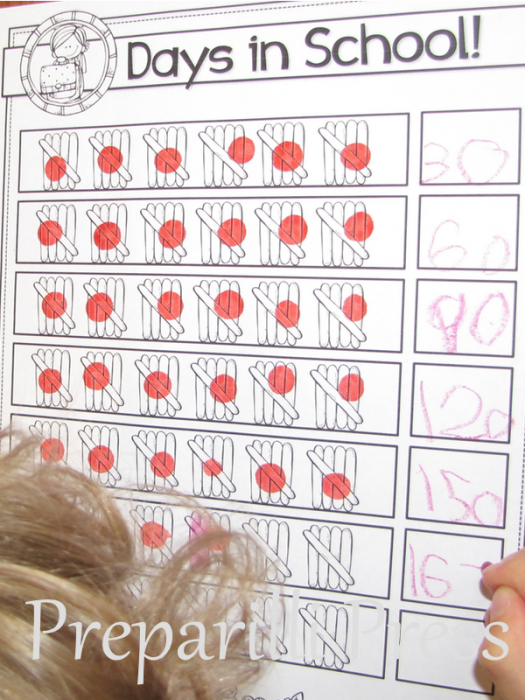
We dot one group of five tallymarks for each week (Monday-Friday) and then shade the remaining days. Skip count by five and add your ones–great mental math!
Grab some coins! It is time to transform the days in school into money. The Money Chart is a great help for your visual learners (be sure to slide this one into a page protector, or laminate it–you’ll want to reuse it all year!). Have them begin by writing the target number at the top of the page. Then build that number beginning with the biggest coins–for example Finn was trying to build 167. First he grabbed a dollar (this eliminates the 100). Next, two quarters (there is the 50); then a dime (now we are at 60); add in a nickel (now we are at 65); and finally grab those pennies, we’ll need 2 to get to 67.
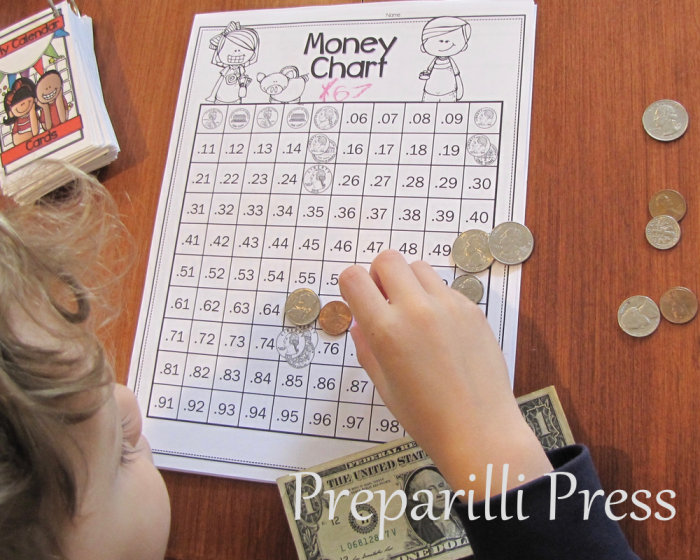
After figuring how to transform days in school into money, your kids will mark it on the monthly sheet.
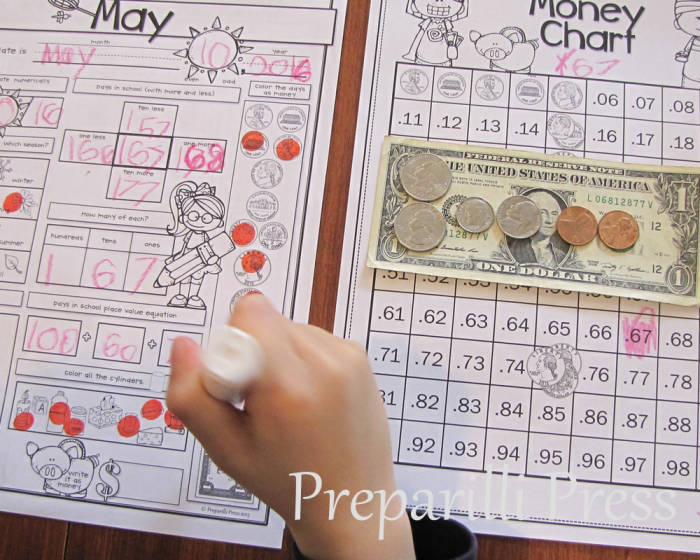
Finn’s sheet for May is different from the ones in the My Calendar Daily Math for First pack. A smart teacher (thank you Sabrina!) encouraged me to modify these sheets to enable you to not only use them once, but re-use them all month. Your students will use dice and the cut-outs at the bottom of the sheets to accomplish a wide variety of math tasks. Here is a look at the five reusable sheets for August:
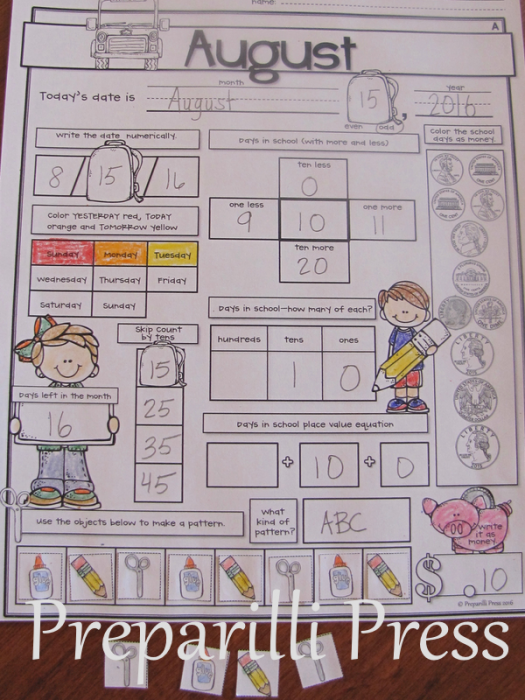
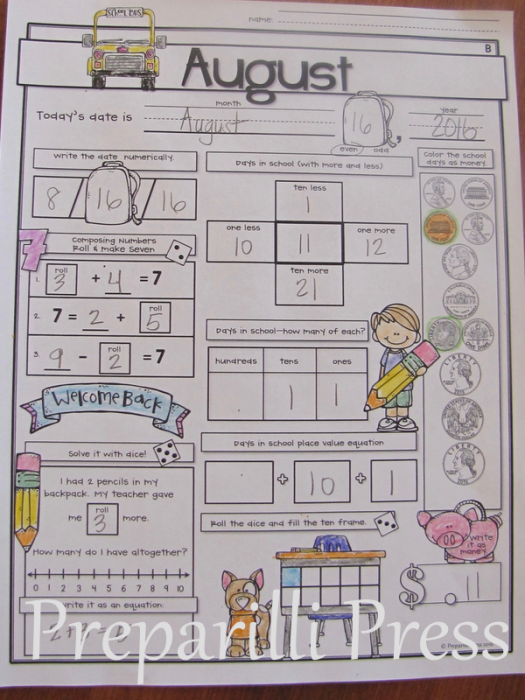
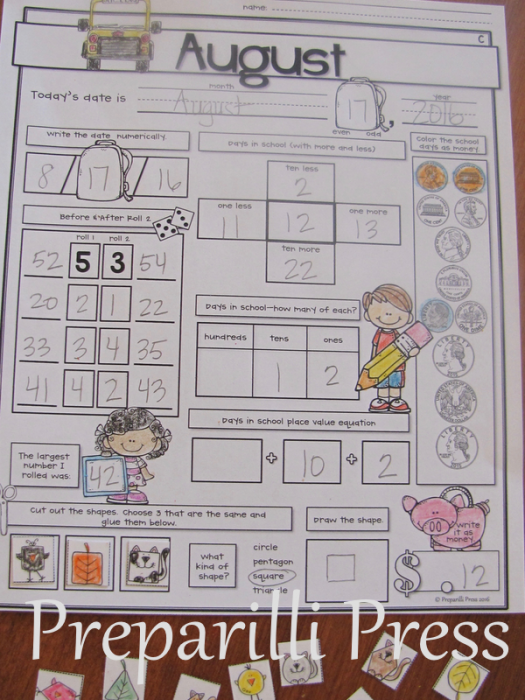
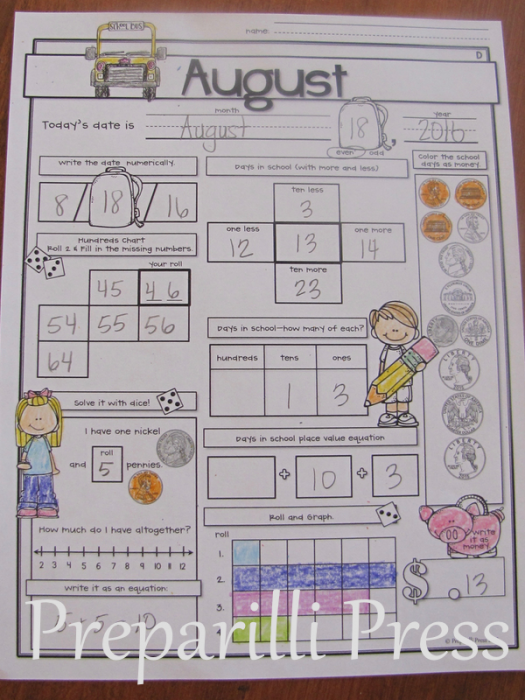
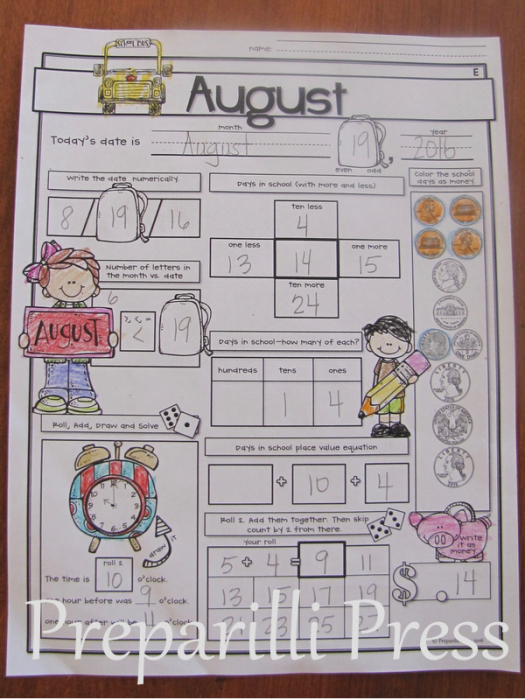
I have more handy tips for using these sheets to post another time. But, right now, you’ll want to head over to Teacher’s Notebook and enter my giveaway! You could win a copy of My Calendar Daily Math for First! Or, grab it for half-off at Teacher Pay Teachers through Saturday!

Did your little jedi’s have fun learning with Kindergarten Jedi? Their adventure continues with PADWAN MATH!
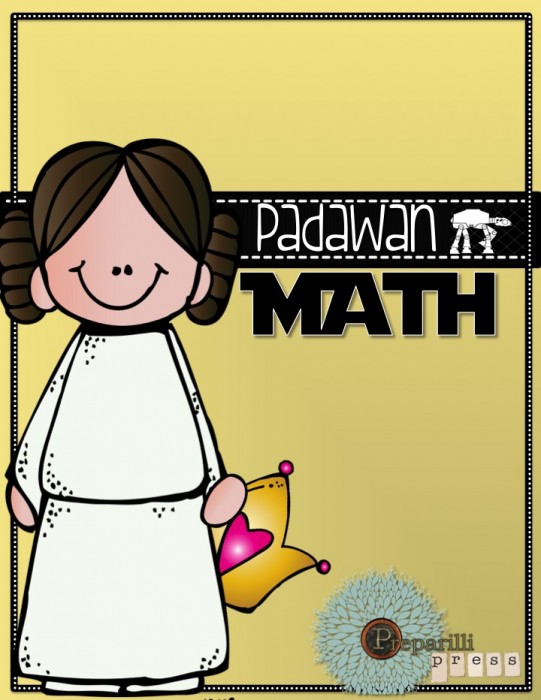
It is a math smorgasbord for First Graders. Here’s a look at what’s included:

**I Spy Shapes Booklet (Color & Count 2- and 3-Dimensional droid shapes)
**May the Fourth Calendar Sheet–includes even/odd; writing the date numerically; season identification; number of days in the month; number of days in school—one more/less and ten more/less; written as hundreds, ten and ones; as a place value equation and as money; skip counting by 4s and a simple word problem based on fourths.
**May the Fourth Ten Frames (Use this sheet to help your students count Days in School—1/2 a ten frame (5 days) for each week
**Stormtrooper’s Skip Counting (by 5s and by 10s)
**Chewie’s Countdown (Write the numbers from 24 to 0 in descending order)
**Chewie’s Ten More/Ten Less (Use the spinner to select a number; then write 10 more & 10 less)
**Luke’s Spin, Write and Subtract (Subtraction within 20)
**Luke’s Lost Addends (fill in the missing number to make the equation true)
**Luke’s Locate and Add (choose the two numbers, when added together, equal the number in the middle of the circle)

**Darth’s Double and Take Two (Double the number given; then subtract two from that answer)
**Yoda’s True or False (sort the equations)
**Leia’s Find the Fraction (Choose the right answer for the fraction represented by the shaded area)
**Leia’s Equivalents (Circle the fractions in each grouping that are equivalent)
**Leia’s Lines of Symmetry (Draw the mirror image of the mask shown)
**Han’s Half-sies (Draw a straight line between the dots to cut the object in half)
**Han’s Halve it! (Color half of each group of items)
**Han’s Teaching Clock (base clock with quarter and half hour overlays)
**Han’s Half Hour Hop (Draw the time on each clock—a half hour more than the time shown on the previous clock)
**Han’s Time to Travel I (time to the half hour)
**Han’s Time to Travel II (time to the quarter hour)
**C3PO’s Droid Store I (More or Less; Write the Inequality)
**C3PO’s Droid Store II (Determine the coins that make the amount of each droid part)
**C3PO’s Money Chart (Use with C3PO’s Droid Store)
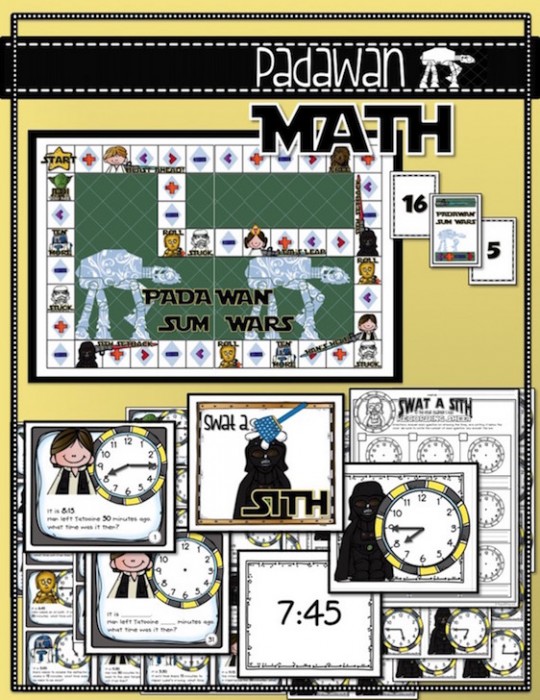
**Padawan Sum Wars Board Game (addition and subtraction within 40, inequalities, adding three numbers, and ten more)
**Swat a Sith Time Game—30 Star Wars themed time scenario cards (quarter, half and full hour before and after). Your students will SWAT the answer to each time change scenario. Clocks for every quarter hour are included. Blank clocks and editable time scenario cards are also included.
Yep, get out the flyswatter–your kids are going to love swatting that Sith!

Winter Pattern Play is such a FUN learning tool! You are going to LOVE it! It is not your average pattern-teaching resource. Instead, it combines pattern identification and skills your students should be mastering (identification of phonemes–beginning and ending letter sounds & blends; one-to-one correspondence; 2-D shapes; colors and skip counting).
Your students will begin learning various patterns (AB, AAB, AABB, ABB, ABC) using the tiles and print-n-teach worksheets.
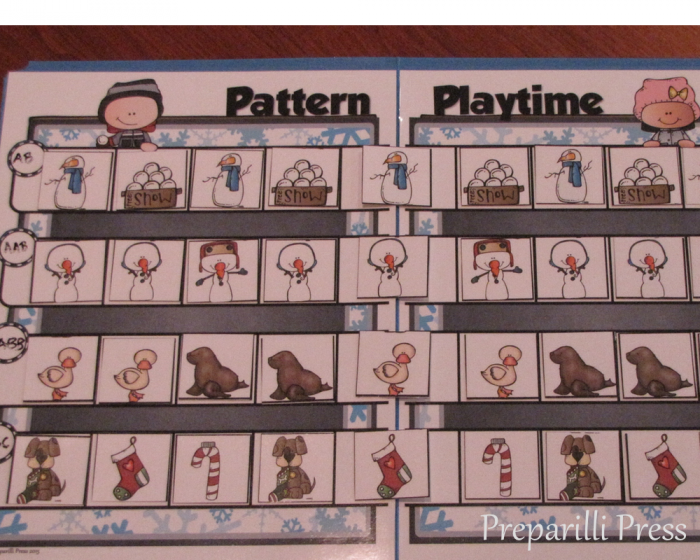
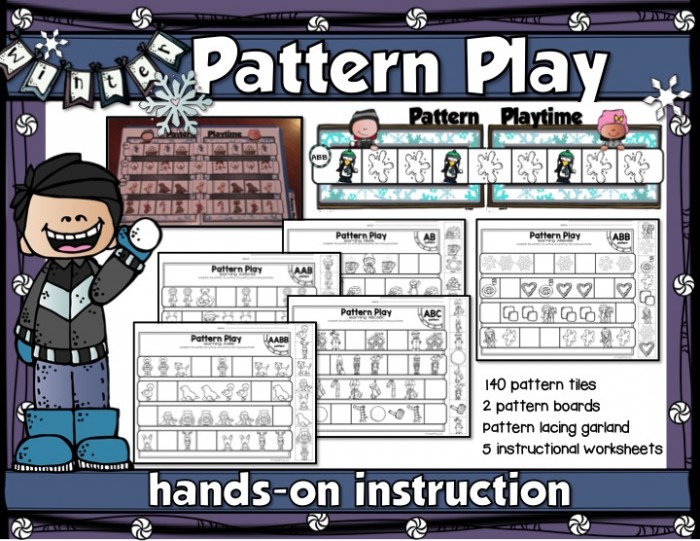
Then, you’ll combine your students’ pattern identification skills with a phonemic review.
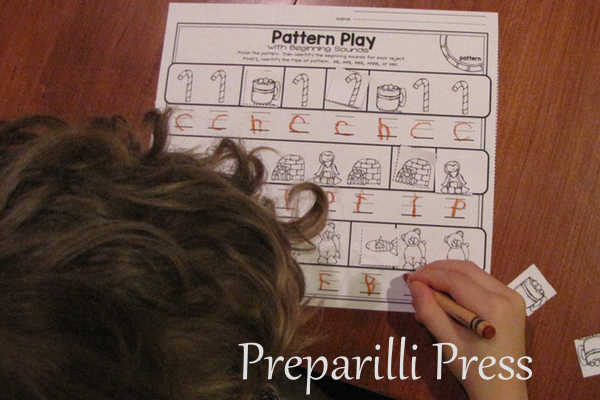
They will listen for beginning and ending letter sounds and blends–like “ch”, “cl”, “ft”, “pr”, “rd”, “sc”, “sl”, “sn”, “st”, “sw”, “th”, and “tr”.
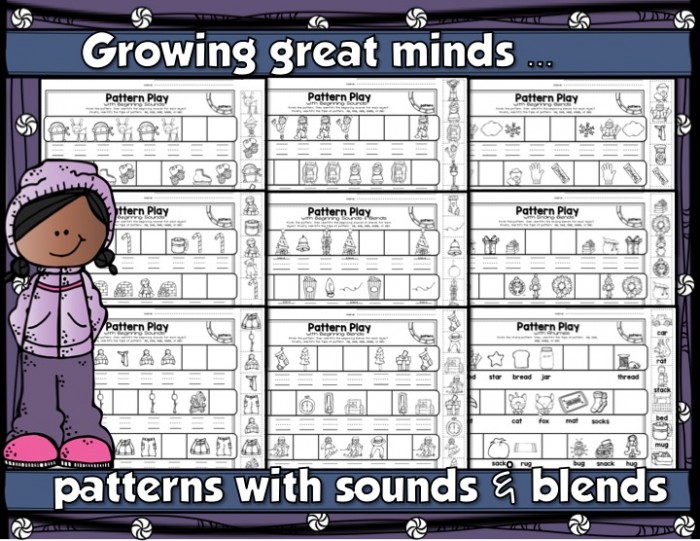
Winter Pattern Play includes a section all about this season’s holidays–complete with pattern and phoneme identification.
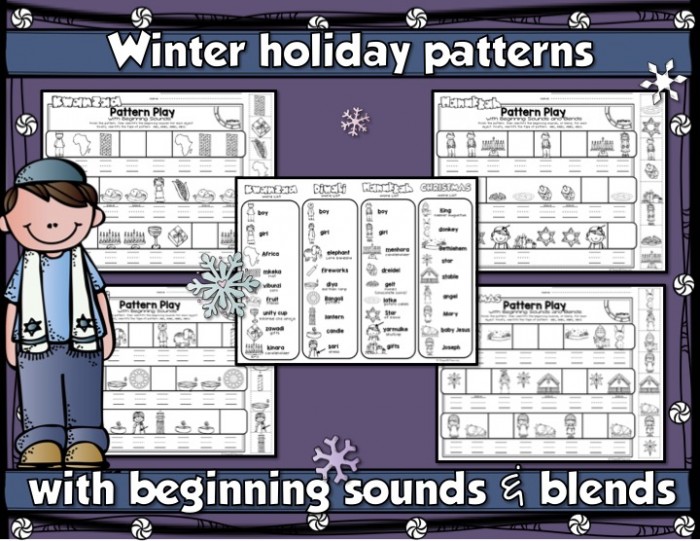
Finally, you’ll develop your students patterning skills with 2-dimensional shape identification and drawing; color patterning; one-to-one correspondence using dice and basic skip counting (by evens/2s, odds, 3s, 4s, 5s, and 10s).
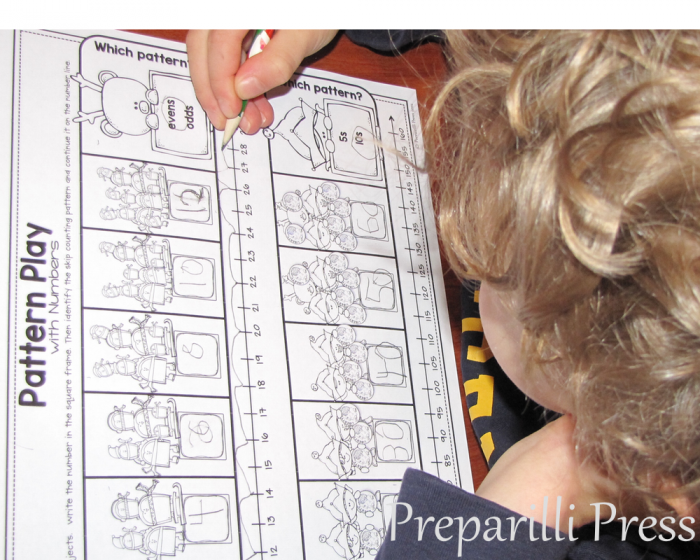
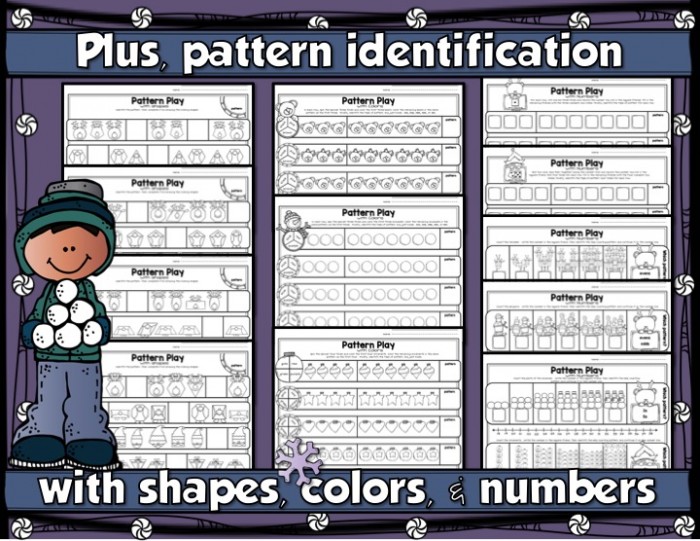
Grab Winter Pattern Play on sale this week, or enter my Teachers’s Notebook giveaway and win it Sunday!!
